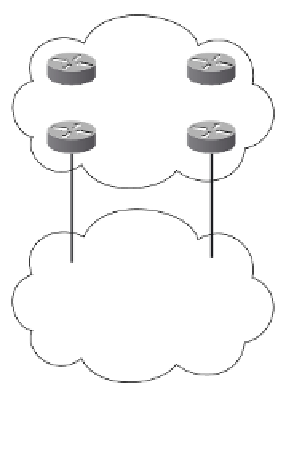Information Technology Reference
In-Depth Information
has multiple border routers in the enterprise network, each with one or more connections to
the upstream provider. In this design, a single upstream provider is still used.
It could be argued that the single upstream provider is a single point of failure. However,
that is only a matter of perspective. If the upstream provider has redundancy in its network,
multiple failures are required to trigger a failure for the enterprise customer.
NOTE
This design scenario is shown in Figure 6-3.
Figure 6-3
Stub Multihomed Multiple Border Router Architecture
Provider A (AS 100)
Enterprise (AS 65100)
It is recommended that BGP be used with this design option. It is possible for the provider
and enterprise to use static routes. However, this does not let the enterprise influence traffic
patterns. This ability is especially important if the links to the upstream provider are
unequally sized or terminate in globally diverse locations, such as in different continents.
The enterprise can still use a private AS in this design. The main advantage of running a
private ASN is that the enterprise does not need to go through the process of acquiring one.
The purpose of running BGP is to provide the enterprise with additional support for defin-
ing inbound and outbound policies. In addition to the eBGP sessions to the upstream pro-
vider, the enterprise should build a full iBGP mesh between the border routers, as well as
between all Layer 3 devices that might be involved in providing transit between the border
routers. This requirement ensures that traffic will not be sent to a device that does not have
routing information for the destination address.






















